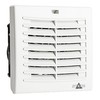PROTECT YOUR INVESTMENT WITH AIRFLOW COOLING
Featured Product from STEGO

PROTECT YOUR INVESTMENT WITH AIRFLOW COOLING
Hot Chattanooga Nights
I remember when my very pregnant wife and I were house hunting in Chattanooga, TN. The house was great, but I noticed this large “device” in the main hallway ceiling. When I asked the realtor, “What is this?”, she told us that this strange contraption was an attic fan. Before the glorious days of A/C, the homeowner would open all the windows in the room and then turn on the attic fan. The fan in the ceiling would suck all the air in the house up through the attic and push it through the vents, drawing fresh air in through the windows.
The thought of hot TN summers being cooled just by an attic fan was not very appealing! Thankfully, the realtor immediately informed us the house did have central air, too. Many older homes throughout the South have attic fans; the reason attic fans are a relic of the past is because they somewhat cool a house but are no match for an A/C system.
I also recall my summer jobs working on chicken farms, with chicken houses cooled by similar technology. An attic fan will never bring a house in August in the deep South down to 70°, but at least it won’t be 100°. Enclosure filter fans work on the same principal. So, what is this filter fan technology, and does it really work – or has its time come and gone?
Choosing optimal cooling solutions
Filter fans have been deployed for decades to protect sensitive electronics in mission critical outdoor applications. There are three (3) effective methods for enclosure cooling:
- Basic ventilation
- Filter Fans
- Industrial grade air-conditioning.
Each of these technologies has its advantages and disadvantages. However, filter fans are at the sweet spot in terms of effectivity and cost-benefit. Filter fans are utilized in a variety of industries and applications such as:
- Telecom
- Cable
- Data Centers, and
- Power Utilities.
Regardless of vertical market, the basic need remains; protect the sensitive electronics from heat in the most cost-effective method. A specific example in the Power Utility vertical market: in recent years, we’ve seen a proliferation of grid modernization via the application of Electronic Reclosers or Intelligent Grid Switching Devices (IGSDs). Most of these applications require a battery to operate the mech. A control cabinet attached to the power pole will be exposed to extreme heat from late Spring to early Fall, and batteries do not like heat. Today utility companies are beginning to explore ways to preserve and extend battery life, and the filter fan is that optimal solution.
Be Gone, Heat! A thermodynamics refresher.
Thermodynamics was one of those classes, like Statics or Dynamics: as an engineer, you either got it or… you retook it. Thermodynamics is a highly complex study of heat transfer, but as one engineer said to me: “Aren’t you just replacing hot air with hot air?”
He may have been right! Regardless, here are three basic truths:
- All electronic components produce heat.
- Electronic components are sensitive to temperature, especially heat.
- The heat exposure problem must be solved so that we don’t damage the electronic components.
The way this is solved on your computer or laptop is via a fan that may kick on to displace the hot air. In fact, you might hear the fan on your computer right now as you read this blog; this is the same process which we are discussing. In short, a filter fan actively removes hot air and draws in cooler air to replace it or actively forces the hot air out, effectively cooling the system.
But, will it blend?
The “will it blend” meme is a bit of geek humor, as various things are dropped in a blender to see what happens. In our case, the question is “But, will it cool?” and thus “What can you do in extend the life of my battery?”
We routinely hear objections in this vein:
“How can a filter plan possibly cool my bright metal control cabinet facing due West in the setting sun of the Arizona desert?”
The fact is – utilizing a filter fan allows the displacement of extremely hot air within the metal cabinet with noticeably cooler (less hot) ambient air outside of the metal enclosure.
- The industry rule of thumb is every 15? above 77? cuts a battery’s life in half.
- These types of temperature differentials can take a 10-year useful life battery down to 2 years.
- In real world applications, we have seen the potential for +30? differentials when utilizing a filter fan
So; using a filter fan will reduce the ambient temperature, thus increasing battery life.
Filter Fan Plus to the rescue
The STEGO Filter Fan Plus series offers 3 unique features to solve your electronic enclosure heat issues.
- AIR FLAP OUTLET TECHNOLOGY improves air flow to achieve more efficient cooling. Also, when not in operation, the flaps say closed and dirt / splash water stays out to achieve a high degree of airflow.
- TOOL FREE INSTALLATION: Built-in ratchet braces snap into place, providing audible feedback confirming it was installed securely.
- TWO STYLES FOR AIRFLOW: the more common “airflow direction IN” draws air in from the outside. Also offered: “airflow direction OUT” to expel heat buildup.
In Versus Out
The FPI system is a standard installation with a filter fan in the lower part of the enclosure which ensures that fresh air is fed into the enclosure (airflow direction “In”). This system consists of a filter fan and exit filter. In the FPO system, the filter fan is located in the upper area of the enclosure to avoid heat buildups (airflow direction “Out”). The FPO system is composed of an intake filter and exit filter fan. The Filter Fan Plus series may also be used outdoors with appropriate protective measures or when equipped with weather proof accessories, e.g. Hose-proof Hood FFH 086.
How’s it work?
Our filter fan systems consist of an intake vent and an exhaust vent (the exhaust vent is at the top of the system because heat rises). The intake vent also has a filter with a G3 rating, which protects against dusts such as sawdust, gross domestic dust and sand. Also, in the system is one electric fan. Our line of filter fans can be powered by both AC and DC currents. The active fan can be offered on either the intake vent or the exhaust vent. If the fan is on the intake vent, then the system is called an FPI. FPI allows Positive pressure inflow. An example of an FPI system is shown in diagram above on left. The intake fan is placed at the bottom of the system and it forces the clean air into the cabinet. This creates a positive pressure in the cabinet that draws air in through the filter and allows the hot air to flow out of the top exhaust flaps without a filter. When the active fan is on the exhaust vent, then the system is called an FPO. FPO actively forces the pressure out.
The difference between an FPI system and an FPO system is that the FPO system has a slightly higher air flow rate. This allows an FPO system to cool the cabinet slightly better than an FPI system. However, an FPI system does a better job of filtering because of the lower airflow rate. Our research shows that an FPO system provides_% more airflow, while an FPI system provides_ % more filtration. Another benefit of an FPO system is that the fan is at the top of the cabinet, which allows more space at the bottom of the cabinet for electronics to be placed inside. At STEGO, we have a wide selection of filter fan options. This includes AC and DC powered fans along with a large selection of sizes to provide different airflow and cooling rates.
Tools for you
Filter fans are very much at the forefront of enclosure cooling technology, even after all these years of attic fans and new A/C systems.
To choose the best size fan for your application, go to https://www.stego-usa.com/nc/support/calculation-tools/cooling-calculation/ and use our cooling calculator. Also, if you need help deciding whether an FPO system, an FPI system, or even a hybrid solution with two active fans is best for you, contact us through our website and will be happy to help you solve your cooling needs.
You can learn more about the advantages of the new Filter Fan Plus by visiting our video link at: https://www.stego-usa.com/products/cooling/filter-fan-plus/
Watch>>STEGO Company Portrait
Follow us on:
STEGO Elektrotechnik GmbH
STEGO - Perfect Thermal Management: Since it was founded in 1980, STEGO Elektrotechnik in Schwaebisch Hall, Germany, has been developing, producing and selling an evergrowing range of products for the protection of electric and electronic components. All STEGO products for cabinets and enclosures - heaters, fan heaters, filter fans, LED-lamps, thermostats, hygrostats and accessories - are aimed at reaching optimum climatic conditions in the most varied environments, en-suring that all sensitive components work reliably at all times. STEGO is now represented at 12 locations and by more than 200 sales partners worldwide.







